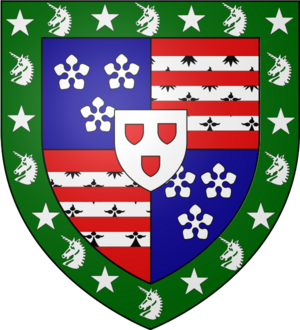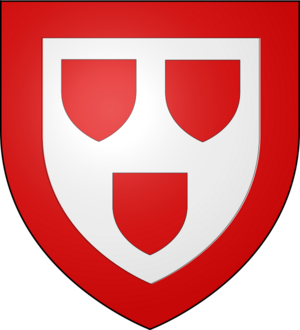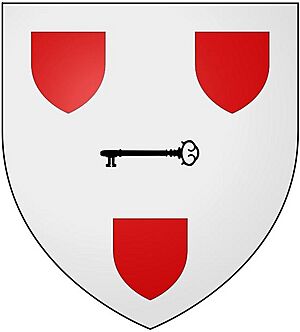Hay baronets facts for kids
The Hay family has had four special titles called baronetcies. All of these titles were created in a system known as the Baronetage of Nova Scotia. Think of a baronetcy as a hereditary title, like a knight, but it passes down through the family. It's a bit like being a "Sir" that your children can also inherit.
Out of these four titles, two no longer exist (they are extinct), one is currently inactive (dormant), and one is still active (extant). There was also a fifth baronetcy created during the Jacobite Peerage, but it's not officially recognized by the Lyon Office, which is like the official record-keeper for Scottish titles.
The first of these titles, the Hay Baronetcy of Smithfield and Haystoun, was created in Peeblesshire on July 20, 1635. It was given to James Hay, who was a special assistant to King James VI. Along with the title, he received a huge amount of land in Nova Scotia, about 16,000 acres (or 65 square kilometers)!
This title became inactive, or dormant, when the third Baronet died in 1683. However, in 1762, another James Hay claimed the title. He was a distant relative of the first Baronet. In 1805, a special group in Perth agreed that his claim was valid. The sixth and seventh Baronets from this line even became Members of Parliament for different areas in Scotland. The title became dormant again in 1966. Today, the Marquess of Tweeddale is thought to be the next in line for this title.
Another title, the Hay Baronetcy of Park, was created in Wigtownshire on August 25, 1663, for Thomas Hay. An interesting fact about this line is that the seventh Baronet married Sarah Cossins. Because of this marriage, his children and their descendants could also potentially inherit the title of Baron Audley.
The Hay Baronetcy of Linplum was created in Haddingtonshire on March 26, 1667. This title was given to James Hay, whose father was the son of the 8th Lord Hay of Yester. This title ended, or became extinct, when the second Baronet died in 1751.
Finally, the Hay Baronetcy of Alderston was created on February 22, 1703, for John Hay. His family was connected to the Hay Baronets of Smithfield and Haystoun and the Marquesses of Tweeddale. Some members of this family, like the third and fourth Baronets, used the combined last name Hay-Makdougall.
A few other notable people from this family include Thomas Hay, who was a judge known as Lord Huntingdon. His younger brother, John Hay of Restalrig, joined Prince Charles Edward Stuart during the Jacobite rising of 1745. Prince Charles even made John Hay a knight and a baronet in the Jacobite Peerage. This Jacobite title later joined with the 1703 Alderston baronetcy in 1825. Another family member, Woulfe Hay, became a Major-General in the British Army.
Contents
Hay Baronets of Smithfield and Haystoun (1635)
- Sir James Hay, 1st Baronet (died 1654)
- Sir John Hay, 2nd Baronet (died about 1659)
- Sir James Hay, 3rd Baronet (1652 – about 1683) (title became dormant)
- Sir James Hay, 4th Baronet (died 1810) (claimed title in 1805)
- Sir John Hay, 5th Baronet (1755–1830)
- Sir John Hay, 6th Baronet (1788–1838)
- Sir Adam Hay, 7th Baronet (1795–1867)
- Sir Robert Hay, 8th Baronet (1825–1885)
- Sir John Adam Hay, 9th Baronet (1854–1895)
- Sir Duncan Edwyn Hay, 10th Baronet (1882–1965)
- Sir Bache McEvers Athole Hay, 11th Baronet (1892–1966) (title became dormant)
Hay Baronets of Park (1663)
- Sir Thomas Hay, 1st Baronet (died around 1680)
- Sir Charles Hay, 2nd Baronet (1662–1737)
- Sir Thomas Hay, 3rd Baronet (around 1730–1777)
- Sir Thomas Hay, 4th Baronet (died 1794)
- Sir James Hay, 5th Baronet (around 1775–1794)
- Sir William Hay, 6th Baronet (1793–1801)
- Sir John Hay, 7th Baronet (1799–1862)
- Sir Arthur Graham Hay, 8th Baronet (1839–1889)
- Sir Lewis John Erroll Hay, 9th Baronet (1866–1923)
- Sir Arthur Thomas Erroll Hay, ISO, 10th Baronet (1909–1993)
- Sir John Erroll Audley Hay, 11th Baronet (1935–2020)
Hay Baronets of Linplum (1667)
- Sir James Hay, 1st Baronet (died 1704)
- Sir Robert Hay, 2nd Baronet (around 1673–1751)
Hay Baronets of Alderston (1703)
- Sir John Hay, 1st Baronet (died 1706)
- Sir Thomas Hay, 2nd Baronet (died 1769)
- Sir George Hay-Makdougall, 3rd Baronet (died 1777)
- Sir Henry Hay-Makdougall, 4th Baronet (around 1750–1825)
- Sir Thomas Hay, 5th Baronet (died 1832)
- Sir James Douglas Hamilton Hay, 6th Baronet (1800–1873)
- Sir Hector Maclean Hay, 7th Baronet (1821–1916)
- Sir William Henry Hay, 8th Baronet (1867–1927)
- (Sir) Edward Hamilton Hay, 9th Baronet (1870–1936)
- Sir Frederick Baden-Powell Hay, 10th Baronet (1900–1985)
- Sir Ronald Nelson Hay, 11th Baronet (1910–1988)
- Sir Ronald Frederick Hamilton Hay, 12th Baronet (born 1941)
Hay Baronets of Restalrig (Jacobite Peerage) (1766)
- Sir John Hay, 1st Baronet (died 1784)
- Sir Alexander Hay, 2nd Baronet (died 1791)
- Sir Thomas Hay, 3rd Baronet (died 1832)
- Sir James Douglas Hamilton Hay, 4th Baronet (1800–1873)
- Sir Hector Maclean Hay, 5th Baronet (1821–1916)
- Sir William Henry Hay, 6th Baronet (1867–1927)
- Sir Edward Hamilton Hay, 7th Baronet (1870–1936)
- Sir Frederick Baden-Powell Hay, 8th Baronet (1900–1985)
- Sir Ronald Nelson Hay, 9th Baronet (1910–1988)
- Sir Ronald Frederick Hamilton Hay, 10th Baronet (born 1941)
See also
- Thomas Hay, Lord Huntingdon
- Clan Hay
- Marquess of Tweeddale
- Dalrymple-Hay baronets
- Moncreiffe baronets
- Baron Audley





